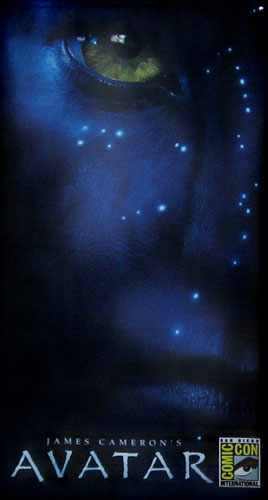|

|
|
A poster of "Avatar"
|
When James Cameron directed his first 3D film, "Terminator 2: 3D," for Universal Studios theme parks more than a decade ago, the bulky camera equipment made some shots awkward or impossible.
The 204-kilogram contraption - which had two film cameras mounted on a metal frame - was so heavy that producers had to jury-rig construction equipment to lift it off the ground for shots from above.
The cameras, slightly set apart, had to be mechanically pointed together at the subject, then locked into place like an unwieldy set of eyes to help create the 3D effect.
At US$60 million, the 12-minute film was the most expensive frame-for-frame production ever.
Now, five months from its release, Cameron's "Avatar," the first feature film he has directed since "Titanic" (1997), promises to take 3D cinematography to an unrivaled level, using a more nimble 3D camera system that he helped invent.
Cameron's heavily hyped return also marks Hollywood's biggest bet yet that 3D can bolster box-office returns. News Corp's 20th Century Fox has budgeted US$237 million just for the production of "Avatar."
"Speechless"
The movie uses digital 3D technology, which requires audience members to wear polarized glasses. It is a vast improvement on the sometimes headache-inducing techniques that relied on cardboard cutout glasses with red and green lenses and rose and fell in popularity in the 1950s.
"Avatar" also raises the bar on "performance capture" technology, which creates computerized images from real human action. The movie depicts an ex-soldier's interactions with 3-meter-tall aliens on the luminous planet of Pandora.
"I'm speechless," said Nahum Villalobos, a 19-year-old Navy recruit from Vista, California, who watched 25 minutes of exclusive footage of "Avatar" along with 6,500 people at the Comic-Con convention in San Diego last week. "It's more extraordinary than any other movie that is out there, or has been."
The US$237 million production is not as expensive as some 2D fare such as "Spider-Man 3" (2007), which was made for US$258 million. But it blows away "Monsters vs Aliens" (2009), a 3D animation movie made for US$175 million.
Then again, Cameron's last film grossed US$1.84 billion worldwide. "Titanic" is the highest grossing film ever.
"If you know Jim Cameron, it's all about pushing the envelope," said Vince Pace, who helped him develop the 3D camera system used in "Avatar."
Cameron tweaked his cameras through two 3D documentaries he made for IMAX theaters, "Ghosts of the Abyss" (2003) and "Aliens of the Deep" (2005).
His camera rig is now lighter - up to only 22 kilograms - and the two camera lenses can dynamically converge on a focal point with the help of a computer, which is crucial for sweeping camera moves and action sequences.
In some of the "Avatar" footage released at Comic-Con, humans filmed with his 3D camera rig are mixed with the computer-generated images of the movie's avatars - beings created with mixed human and alien DNA.